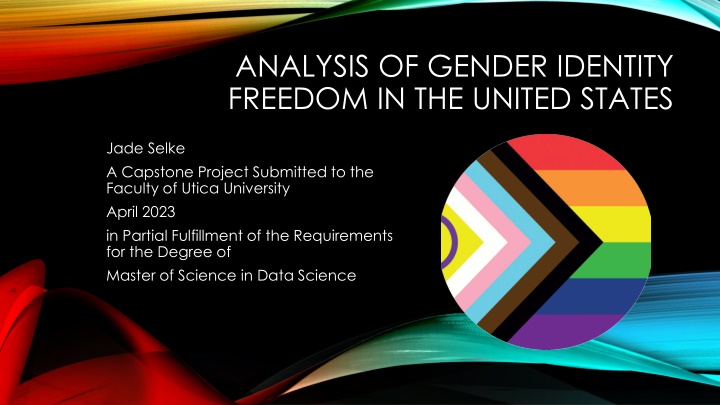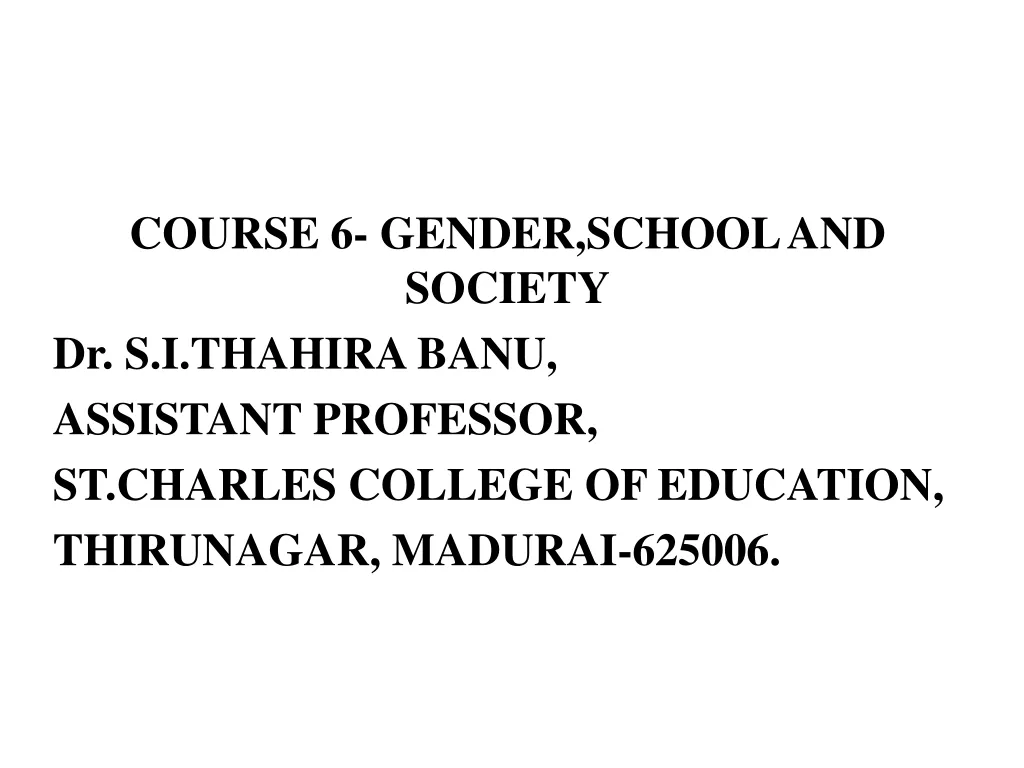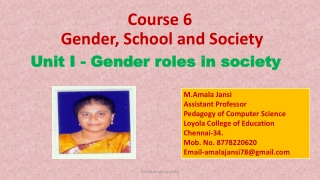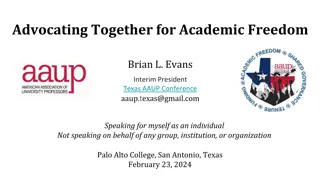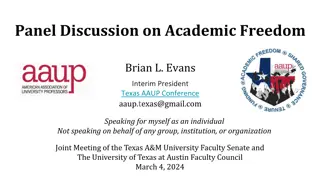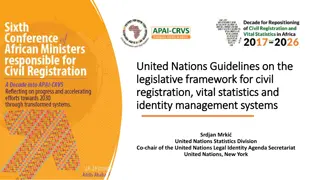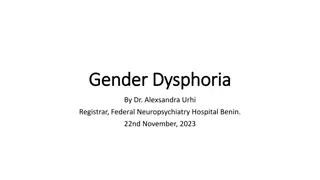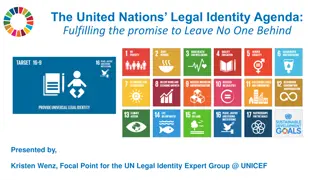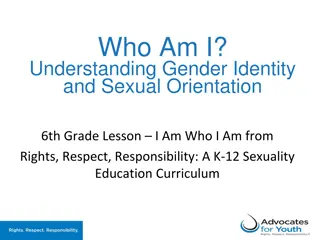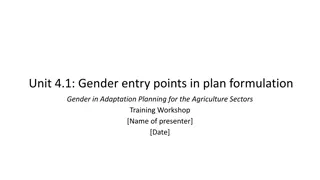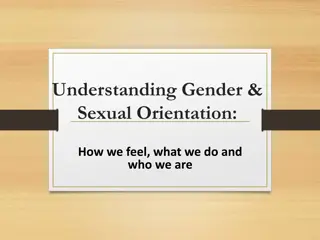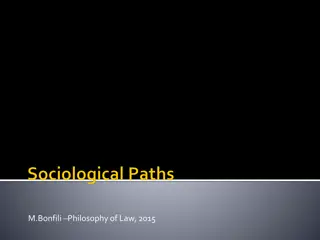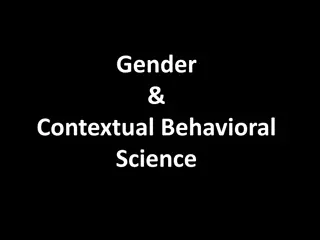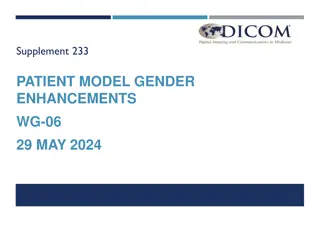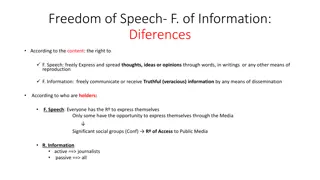Analysis of Gender Identity Freedom in the United States
The project evaluates the increasing diversity of gender identities and the associated legal and societal implications in the US. It explores data on transgender populations, discrimination, and the impact of religiosity. The study aims to shed light on the challenges faced by individuals identifying outside the gender binary.
Download Presentation

Please find below an Image/Link to download the presentation.
The content on the website is provided AS IS for your information and personal use only. It may not be sold, licensed, or shared on other websites without obtaining consent from the author.If you encounter any issues during the download, it is possible that the publisher has removed the file from their server.
You are allowed to download the files provided on this website for personal or commercial use, subject to the condition that they are used lawfully. All files are the property of their respective owners.
The content on the website is provided AS IS for your information and personal use only. It may not be sold, licensed, or shared on other websites without obtaining consent from the author.
E N D
Presentation Transcript
ANALYSIS OF GENDER IDENTITY FREEDOM IN THE UNITED STATES Jade Selke A Capstone Project Submitted to the Faculty of Utica University April 2023 in Partial Fulfillment of the Requirements for the Degree of Master of Science in Data Science
The percentage of people identifying as other than cisgender is increasing The number of people who identify as transgender or nonbinary across different regions can vary greatly Throughout the world, the lack of protections based on gender means that any person identifying their gender outside the binary necessarily places them in marginalized positions This project will use datasets in which people identify their gender, location, income, and regional religiosity in the US, as well as those that look at the relative penalty of laws governing the freedom to identify as a gender other than male or female INTRODUCTION
LITERATURE REVIEW Collection and Time Analysis Discrimination and Legal Consideration Religiosity Traditional survey methods do not come close to capturing the full diversity of identities and experiences The self-reported transgender population increased from 0.15% to 0.35% over ten years (2006-2016) Exclusion of trans rights may cause them to avoid self-identification Correcting future discrimination relies on pushing against the court s reliance on biological sex Free exercise of religion must be a deliberate and delicate topic Vocal conservative majorities can make people feel unsafe to self- identify
METHODOLOGY DATA SETS - POPULATIONS Population Over Time Metadata Variable Name Description Data Type Role Example stateId Unique identifier for each of the 50 US states Nominal IV 6 stateName Unique name of US state Nominal California statePop2020 Population of the corresponding state for 2020 Interval, numeric IV 39338223 statePop2023 Population of the corresponding state for 2023 Interval, numeric IV 40223504 transPop2016 Estimated transgender population of the corresponding state for 2016 Interval, numeric IV 218400 transPercent2016 Estimated transgender population as a percentage of the corresponding state population for 2016 Ordinal, numeric IV 0.76 transPop2022 Estimated transgender population of the corresponding state for 2022 Interval, numeric IV 150100 transPercent2022 Estimated transgender population as a percentage of the corresponding state population for 2022 Ordinal, numeric IV 0.49
Variable Name stateId religionImp2014 Description Data Type Role IV IV Example Unique identifier for each of the 50 US states Percentage of respondents by state who reported religion is important for Pew Study 2014 Percentage of respondents by state who reported weekly church attendance for Pew Study 2014 Percentage of respondents by state who reported praying once or more per day for Pew Study 2014 Percentage of respondents by state who reported certainty of God s existence for Pew Study 2014 Percentage representing overall religiosity of all respondents in a state for Pew Study 2014 Percentage of respondents by state who reported themselves as very religious for Gallup poll 2017 Percentage of respondents by state who reported themselves as moderately religious for Gallup poll 2017 Percentage of respondents by state who reported themselves as nonreligious for Gallup poll 2017 Marked 1 if state prevents absentee voting, 0 otherwise for religious liberty 2022 Marked 1 is state does not require childhood immunization, 0 otherwise for religious liberty 2022 Range of values from 0 to 20 based on how many laws are in place per state to allow individuals to opt out of issuing or providing contraception, sterilization, and abortion procedures to others for religious liberty 2022 Marked 1 if state has additional laws to prevent the purchase or issuance of contraceptives, 0 otherwise for religious liberty 2022 Nominal Ordinal, numeric 6 0.50 worshipWeekly2014 Ordinal, numeric IV 0.34 prayDaily2014 Ordinal, numeric IV 0.51 certainAboutGod2014 Ordinal, numeric IV 0.61 overall2014 Ordinal, numeric IV 0.51 veryReligious2017 Ordinal, numeric IV 0.35 modReligious2017 Ordinal, numeric IV 0.29 METHODOLOGY DATASETS - RELIGIOSITY nonreligious2017 Ordinal, numeric IV 0.36 relLibVote2022 Ordinal, categorical IV 0 or 1 relLibVax2022 Ordinal, categorical IV 0 or 1 relLibHealth2022 Ordinal, categorical IV 0,1, 2 19, 20 relLibMandate2022 Ordinal, categorical IV 0 or 1 relLibMarriage2022 Range of values from 0 to 4 based on how many laws allow an entity to exempt itself from participating in a marriage celebration or ceremony for religious liberty 2022 Marked 1 if state does not add any extra burden on the free practice of religion, 0 otherwise for religious liberty 2022 Ordinal, categorical IV 0,1,2,3,4 relLibRfra2022 Ordinal, categorical IV 0 or 1 relLibScore2022 Overall weighted score with a range from 0 to 1, based on the other data for this set for religious liberty 2022, where values closer to 1 are considered to have more religious liberty Ordinal, numeric IV 0.8052
METHODOLOGY DATASETS ANTI-TRANS LEGISLATION RISK INDEX Variable Name Description Data Type Role Example stateId Unique identifier for each of the 50 US states Range of values from 0 to 4 based on the number of current and proposed anti-trans bills as well as the severity of the bills for a state for November, 2022 Range of values from 0 to 4 based on the number of current and proposed anti-trans bills as well as the severity of the bills for a state for December, 2022 Range of values from 0 to 4 based on the number of current and proposed anti-trans bills as well as the severity of the bills for a state for March, 2023 Nominal IV 6 antiTrans112022 Ordinal, categorical 0,1,2,3,4 antiTrans122022 Ordinal, categorical IV 0,1,2,3,4 antiTrans032023 Ordinal, categorical IV 0,1,2,3,4
Variable Name SCRAM WEEK Description Data Type Nominal Ordinal, categorical Role Example Unique identifier for the survey respondent Range of values from 34 to 54 to identify the week the Pulse Survey was conducted on V340000001 34, 35, 36, 53, 54 IV EST_ST TBIRTH_YEAR Unique identifier for each of the 50 US states Year of birth for the survey respondent, must be less than 2005 for adults Nominal Discrete, numerical IV IV 6 1967 EEDUC Numerical representation of survey respondent s highest level of education:1 less than high school 2 some high school 3 high school or equivalent 4 some college 5 Associate s degree 6 Bachelor s degree 7 Graduate degree Ordinal, categorical IV 1, 2, 3, 4, 5, 6, 7 METHODOLOGY DATASETS UCSB PULSE SURVEYS EGENID_BIRTH Numerical representation of survey respondent s sex assigned at birth, 1 for male and 2 for female Ordinal, categorical IV 1, 2 GENID_DESCRIBE Numerical representation of respondent s gender identification at the time of the survey: 1 man 2 woman 3 transgender 4 none of these Ordinal, categorical DV 1, 2, 3, 4 SEXUAL_ORIENT Numerical representation of respondent s sexual orientation at the time of the survey: 1 gay or lesbian 2 straight 3 bisexual 4 something else 5 do not know Ordinal, categorical IV 1, 2, 3, 4, 5 INCOME Numerical representation of respondent s income range at the time of the survey: 1 - $0 to $24,999 2 - $25,000 to $34,999 3 - $35,000 to $49,999 4 - $50,000 to $74,999 5 - $75,000 to $99,999 6 - $100,000 to $149,999 7 - $150,000 to $199,999 8 - $200,000 or more Ordinal, categorical IV 1, 2, 3, 4, 5, 6, 7, 8 END_DATE Date of the end of the week for the Pulse Survey Date time IV 8/2/2021
Variable Name statePop2020 statePop2023 transPop2016 transPercent2016 transPop2022 transPercent2022 religionImp2014 worshipWeekly2014 prayDaily2014 certainAboutGod2014 overall2014 veryReligious2017 modReligious2017 nonreligious2017 relLibVote2022 relLibVax2022 relLibHealth2022 relLibMandate2022 relLibMarriage2022 relLibRfra2022 relLibScore2022 antiTrans112022 antiTrans122022 antiTrans032023 n 50 50 50 50 50 50 50 50 50 50 50 50 50 50 50 50 50 50 50 50 50 50 50 50 mean 6615242 8960485 27654 0.4202 26638 0.2980 mode min 576851 580817 1400 0.3000 2100 0.2000 32.0 21.0 33.0 40.0 33.0 16.0 16.0 12.0 median 4581796 4625424 19450 0.5350 16950 0.5250 max 39538223 40223504 218400 0.7800 150100 0.8700 -- -- -- -- -- -- -- -- -- -- -- -- -- -- 1 1 5 1 0 0 7436124 19076310 36854 0.1217 29081 0.1269 -- -- -- -- -- -- -- -- -- -- -- -- -- -- -- -- 51.0 35.5 53.0 63.0 54.0 36.5 29.5 34.0 77.0 53.0 75.0 82.0 77.0 59.0 33.0 59.0 METHODOLOGY STATE LEVEL STATISTICS 0.800 0.900 6.760 0.640 1.160 0.480 0.3939 1.82 1.86 2.00 0.404 0.303 4.023 0.485 1.490 0.505 0.1333 1.34 1.34 1.60 0 0 0 0 0 0 1 1 1 1 5.5 20 1 5 1 1 0 0 0.3377 0.1558 0.3712 0.8182 1 3 4 0 0 0 2 2 2 4 4 4
Variable Name WEEK EST_ST TBIRT_YEAR EEDUC EGENID_BIRTH GENID_DESCRIBE SEXUAL_ORIENT INCOME INCOMEMIN mean mode min median max -- -- 43 -- -- 34 -- -- 54 56 6 1 1969 1955 1.640 1933 1968 2005 -- -- -- -- -- 6 2 2 2 5 -- -- -- -- -- 1 1 -- -- 1 0 6 2 -- -- 5 7 2 -- -- 8 79359 100000 58849 75000 200000 Note. Based on an analysis of 1,048,575 responses from weeks 34 to 54. METHODOLOGY PULSE SURVEY STATISTICS
70000 60000 50000 40000 30000 20000 10000 0 34 35 36 37 38 39 40 41 42 43 44 45 46 47 48 49 50 51 52 53 54 Cisgender Men Cisgender Women Total Transgender METHODOLOGY PULSE GENDER REPORTING BY WEEK
MODELING FULL DATASET
MODELING SEXUALITY REMOVED
MODELING LR FULL DATASET
MODELING LR ACCURACY AND COEFFICIENT VALUATIONS Data Set Description Accuracy Sex Assigned at Birth Coefficient Sexuality Coefficient Only Sex Assigned at Birth Removed 51.0% -- 0.402 Only Sexuality Column Removed 70.9% 0.112 -- And Anti-Legislation Data Removed 66.8% 0.113 0.401 And Pew 2014 Data Removed 66.9% 0.112 0.403 And Statista 2017 Data Removed 68.0% 0.110 0.405 And Religious Liberty Data Removed 71.0% 0.112 0.403
Results Highly accurate models A/B Testing show near identical correlation and predictability strength between: Anti-trans legislation State religiosity Individual religious freedom Highest indicator for prediction is Sexuality CONCLUSION & RESULTS Limitations Can only predict the known transgender population Lack of standards provides non-robust data sets Conclusion Legal and religious factors have a substantial effect on self- identification Inability to quantify individual coefficients points to need for better data
REFERENCES Erni, J. (2013). Legitimating Transphobia. Cultural Studies, 27(1), 136 159. Retrieved from https://doi-org.ezproxy.utica.edu/10.1080/09502386.2012.722305 Estelle, S. M. (2022). Religious Liberty in the States 2022. First Liberty Initiative Center for Religion, Culture, and Democracy. Retrieved from https://religiouslibertyinthestates.s3.us-east- 2.amazonaws.com/Religious_Liberty_in_the_States_Report-2022.pdf Flynn, T. (2001). Transforming the Debate: Why We Need to Include Transgender Rights in the Struggles for Sex and Sexual Orientation Equality. Columbia Law Review, 101(2), 392 420. Retrieved from https://doi.org/10.2307/1123803 Lipka, M., Wormald, B. (2016, February 29). How religious is your state? Pew Research Center. Retrieved from https://www.pewresearch.org/fact-tank/2016/02/29/how-religious-is-your- state/?state=alabama Loh, J. U. (2018). transgender identity, sexual versus gender rights and the tools of the Indian state. Feminist Review, 119, 39 55. https://www.jstor.org/stable/26776500 Meerwijk, E. L., & Sevelius, J. M. (2017). Transgender Population Size in the United States: a Meta- Regression of Population-Based Probability Samples. American Journal of Public Health, 107(2), e1 e8. Retrieved from https://doi-org.ezproxy.utica.edu/10.2105/AJPH.2016.303578
REFERENCES - DATASETS Estelle, S. M. (2022). Religious Liberty in the States 2022. First Liberty Initiative Center for Religion, Culture, and Democracy. Retrieved from https://religiouslibertyinthestates.s3.us-east- 2.amazonaws.com/Religious_Liberty_in_the_States_Report-2022.pdf Duffin, E. (2022, September 30). Religiosity in the United States in 2017, by state. Statista. Retrieved from https://www.statista.com/statistics/221454/share-of-religious-americans-by-state/ Flores, A. R., Herman, J. L., Gates, G. J., Brown, T. N. T. (2016 June). How Many Adults Identify as Transgender in the United States? UCLA School of Law, Williams Institute. Retrieved from https://williamsinstitute.law.ucla.edu/wp-content/uploads/Trans-Adults-US-Aug-2016.pdf Herman, J. L., Flores, A. R., O Neill, K. K. (2022, June). How Many Adults and Youth Identify as Transgender in the United States? UCLA School of Law, Williams Institute. Retrieved from https://williamsinstitute.law.ucla.edu/wp- content/uploads/Trans-Pop-Update-Jun-2022.pdf Reed, E. (2022, November 15). The Post-Election Anti-Trans Legislative Landscape. Erin In The Morning. Retrieved from https://erininthemorn.substack.com/p/the-post-election-anti-trans- legislative?utm_source=profile&utm_medium=reader2 Reed, E. (2022, December 30). The Final Anti-Trans Legislative Risk Map Of 2022. Erin In The Morning. Retrieved from https://erininthemorn.substack.com/p/the-final-anti-trans-legislative Reed, E. (2023, March 18). March Anti-Trans Legislative Risk Map. Erin In The Morning. Retrieved from https://erininthemorn.substack.com/p/march-anti-trans-legislative-risk United States Census Bureau. (2023, March 20). Household Pulse Survey Public Use File (PUF). Retrieved from https://www.census.gov/programs-surveys/household-pulse-survey/datasets.html World Population Review (2023). US States Ranked by Population 2023. Retrieved from https://worldpopulationreview.com/states
